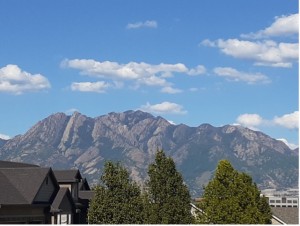 I sat at my newly-made-up-work-from-home office thinking “Why toilet paper?” and suddenly songs from Urinetown: The Musical burst into my head. It seemed appropriate given the sudden and limited supply of the product. (Yes, that really is the name of the musical. It won three Tonys in 2002.) Then two days later on March 18, I was shaken awake by the rumblings of Utah’s 5.7 magnitude earthquake and Carole King sounded in my ear with “I feel the earth move under my feet” as the numerous aftershocks followed, and I wished for only one disaster at a time. By the end of that first week of quarantine, I wanted to be done with telecommuting and broke out with “I want to break free / I want to break free” at the end of the work day.
I sat at my newly-made-up-work-from-home office thinking “Why toilet paper?” and suddenly songs from Urinetown: The Musical burst into my head. It seemed appropriate given the sudden and limited supply of the product. (Yes, that really is the name of the musical. It won three Tonys in 2002.) Then two days later on March 18, I was shaken awake by the rumblings of Utah’s 5.7 magnitude earthquake and Carole King sounded in my ear with “I feel the earth move under my feet” as the numerous aftershocks followed, and I wished for only one disaster at a time. By the end of that first week of quarantine, I wanted to be done with telecommuting and broke out with “I want to break free / I want to break free” at the end of the work day.
Now, 18 months have passed since the earthquake, and my playlist has grown as Madame Corona has provided more than enough challenges for us all. One might say that the hits just keep on coming (pun intended). It’s amazing how many of Queen’s greatest hits relate to Madame C in my view!
But it takes more than a fantastic playlist to cope with the coronavirus. Our EDR program exists to cultivate a culture of collaboration on environment and natural resource issues, and the staff have been leaders in adapting to online teaching, training, and coaching with high impact. Yet, I’ve spent a lot of time by myself lately and even as an introvert, there are still days with depression and wanting some sort of human and personal interaction. Technology, such as Zoom, FaceTime, Google Chat, have helped immensely to connect family, friends, and work colleagues to keep those feelings of isolation at bay and keep communication flowing.
Get notified when new articles are posted to the EDR blog. Sign up for our email list »
As I’ve collaborated with myself and “listen[ed] empathetically for [my] underlying needs” (from William Ury’s Getting to Yes with Yourself), it has been important to focus on the present and appreciate what is before me. So many people have died and suffered and many struggle to make ends meet; uncertainty abounds and who knows where Madame C will take us next given the nature of hits we’ve had so far. The anxiety—the fear—amplify those feelings of hopelessness and despair. Yet, it is possible to appreciate the good things in life by focusing on a new or alternative perspective in the present. I’m not talking about gratitude or being thankful (although that is important), I’m talking about the other definitions for ‘appreciate’: 1) to value or regard highly; place a high estimate on; and 2) to be fully conscious of; be aware of; detect.
It’s easy enough to say “I appreciate this or that,” but sometimes our expressions of gratitude or appreciation can be said mindlessly. So how can we take appreciation to a deeper and more genuine level?
Dr. Ellen Langer, a social psychologist, presented at Talks at Harvard College last year where she discusses the differences between mindfulness versus mindlessness and argues that the consequences for being in either state are enormous. She describes mindlessness as an individual “acting like an automaton where the past is overdetermining the present; an individual is oblivious to how behavior changes based on perspective or context, and that behaviors tend to be rule-and routine-governed.” On the other hand, Langer notes that mindfulness is “the simple process of noticing new things, which make an individual present, sensitive to context and perspective; it’s the essence of engagement and therefore energy begetting, and it’s fun.”
She then shares a few studies measuring the results of mindfulness and mindlessness and concludes that when individuals allow things to vary—to appreciate uncertainty—new possibilities open up, which lead individuals to be more mindful, improving “[their] health, [their] happiness, and [their] vitality.”
Dr. Langer’s ideas on mindfulness can be put into practice simply with: “Pause. Take a breath. What do you see?”
And on a particularly stress-filled and anxiety-ridden day, I saw blue sky with a few tufts of clouds. Snow-capped mountains, rocky ridges, green slopes—the familiar brown and jagged edges of the Wasatch mountain range spanning north and south, heightened by sunlight. A new perspective, getting me out of my head and in the present moment to appreciate the amazing view before me.
Musicians are writing new songs expressing what we are co-learning in these pandemic moments. Madame C’s learning curriculum is continuing to keep us in a constantly-evolving state, yet it is still possible to be present to all of it. Try noticing a sight, a sound, the temperature, and, voila, Langer assures us: Now you are here.
 Angela Turnbow is a program manager at the S.J. Quinney College of Law. She provides support for the Master of Legal Studies program, Utah Law Review, and the EDR blog.
Angela Turnbow is a program manager at the S.J. Quinney College of Law. She provides support for the Master of Legal Studies program, Utah Law Review, and the EDR blog.
